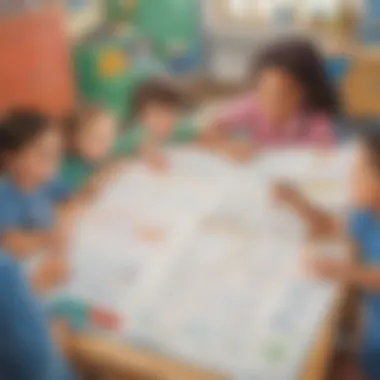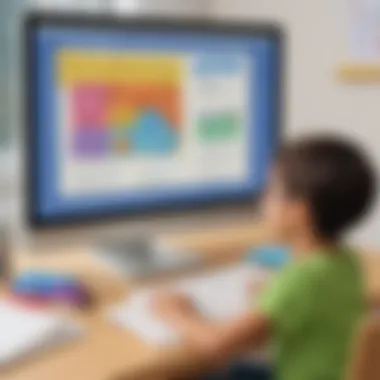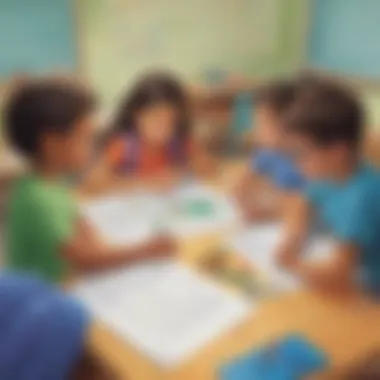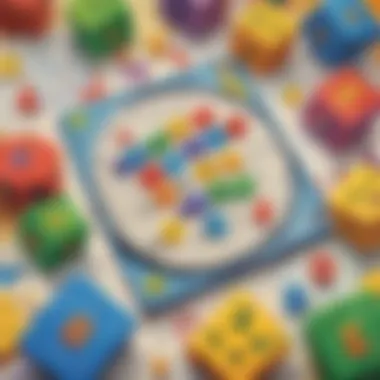Discovering Free Math Resources for Second Graders


Intro
Engaging children in math from an early age is crucial for their confidence and future academic success. Second graders are often excited about learning but can be easily overwhelmed by the complexity of math concepts. This is why offering fun and accessible math resources is essential. Understanding how to harness these resources can significantly enhance both classroom and home learning experiences.
In this article, we will explore various free math resources available for second graders. We will look at activities that are not only educational but also enjoyable. The goal is to provide parents and educators with practical ideas to foster a positive attitude towards math among young learners. By diving into online platforms, educational games, and seasonal activities, we aim to equip caregivers with tools to inspire children in their mathematical journeys.
The sections that follow will cover a variety of topics. We will start with fun activity ideas that keep children engaged while learning math. Next, we will discuss educational games that make math practice exciting. Seasonal activities will also be highlighted to contextualize learning throughout different times of the year. Additionally, we will offer parenting tips focused on how to create conducive learning environments. Finally, we'll conclude with some fun facts and trivia that can reinforce learning in a playful manner.
Preamble to Math Learning for Second Graders
Understanding math at a young age sets the foundation for future academic success. Second graders are at a critical juncture in developing their mathematical competencies. In this stage, children transition from basic numeric recognition to more complex problem-solving skills. The resources available to support this learning journey are essential for educators and parents.
Importance of Early Math Skills
Early math skills play a significant role in cognitive development. Engaging young learners with math enhances their logical reasoning and critical thinking abilities. The ability to manipulate numbers allows children to understand their world better, equipping them with skills necessary for everyday tasks. Research indicates that foundational math skills can predict later academic success. This makes it crucial for parents and teachers to prioritize math education in early years.
Access to free math resources provides children with diverse learning opportunities. These resources can help bridge any gaps in understanding and support varied learning styles. Moreover, regular practice through interactive activities can also foster a sense of confidence in students.
Overview of Common Math Concepts
Second graders typically encounter several key concepts in mathematics, which include addition, subtraction, and an introduction to multiplication. Understanding place value becomes crucial. This concept allows students to grasp larger numbers and comprehend the number system's structure.
Timing also plays an important role. Kids begin to learn to tell time and understand fractions as parts of a whole. The curriculum may also cover basic geometry concepts, introducing shapes and their properties. Familiarity with these concepts prepares students for more advanced math in the future. Teachers and parents should focus on these areas to ensure a comprehensive approach to math learning.
In summary, the right resources and activities can engage second graders effectively. This actively supports their development in mathematical concepts. The quest for effective educational resources is vital and lays a robust groundwork for advanced learning later on.
Characteristics of Effective Math Resources
In the quest for meaningful math education for second graders, there are certain characteristics that effective resources must embody. The quality of these materials can significantly influence a child’s learning experience and their subsequent performance in math. Resources should not only teach but also motivate and engage. All elements of effective resources work together to support and enhance a child’s mathematical journey.
Alignment with Curriculum Standards
Resources that align with established curriculum standards are crucial. These standards provide a framework for what students should learn at various grades. When math resources match these standards, they ensure that learners are acquiring the necessary skills and knowledge. This alignment helps parents and educators track progress easily. Furthermore, it reassures them that the materials they are using prepare students adequately for future math challenges. Specific subjects like addition, subtraction, and basic geometry should be covered in a way that mirrors what students learn in school. This helps build a seamless learning experience between home and classroom.
Engagement and Interactivity
Engagement is essential when working with young learners. Second graders often have short attention spans and need stimulation to remain focused. Resources that incorporate interactive elements increase student interest. This could be through games, quizzes, or animations that draw children in. The goal is to make math fun rather than a chore. Engaging resources encourage children to explore math concepts at their own pace. They also often provide instant feedback, allowing students to see their mistakes and learn from them immediately. Such interactivity fosters a sense of accomplishment and builds confidence in their math abilities.
Adaptability for Diverse Learning Styles
Every child learns differently, and effective math resources must cater to various learning styles. Some children are visual learners who benefit from diagrams and pictures. Others may be auditory learners who grasp concepts better through discussion or listening. Kinesthetic learners may require hands-on activities to understand. Therefore, it is vital that math resources offer diverse methods of teaching concepts. This adaptability can help meet the needs of all learners in the classroom. Additionally, accommodating diverse learning styles ensures that no child is left behind in their math studies. This increases overall achievement and creates a positive learning atmosphere.
"The right materials can transform how a child approaches learning, especially in math."


In summary, effective math resources for second graders should align with curriculum standards, engage students through interactive elements, and adapt to various learning styles. This combination not only facilitates learning but also fosters a love for math. When children enjoy what they are doing, they are more likely to invest in it and develop essential skills.
Online Platforms Offering Free Math Resources
The significance of online platforms offering free math resources cannot be overstated. In an age where digital literacy is vital, parents, educators, and caregivers must utilize these resources to ensure second graders are engaged in meaningful math activities. These platforms not only provide accessibility but also a range of materials that can foster mathematical understanding from a young age. With a proper integration of technology, learning math can transform into a captivating journey for young learners.
Educational Websites Dedicated to Math
Several educational websites are created specifically with math in mind. Websites like Khan Academy offer a diverse range of interactive lessons that cover essential skills in a way that is tailored for young children. These sites often include video tutorials, practice problems, and instant feedback mechanisms.
Other platforms such as Coolmatkids present math in a fun and engaging way, using games and interactive challenges to stimulate learning. This approach can increase a child's enthusiasm for the subject and encourage them to practice more. Furthermore, accessing resources from well-known educational sites can help prevent parents and teachers from worrying about the quality of materials, as they usually align with curriculums.
Interactive Learning Tools and Applications
Interactive learning tools have become essential in modern education, bridging the gap between traditional learning and engaging practices. Tools like Prodigy Math offer an adaptive learning experience, allowing second graders to explore math concepts through gamification. Students can embark on quests and quests that require them to solve math-related problems to progress.
Other applications, such as ABCmouse, provide a well-rounded educational environment, incorporating various subjects, including math. These tools can often be accessed on multiple devices, making them suitable for home and school learning.
Incorporating these interactive tools into a child's routine can keep them interested and motivated to learn. It also promotes self-paced learning, accommodating various learning speeds among students.
Online Workbooks and Printable Worksheets
Online workbooks and printable worksheets offer a fantastic way to supplement interactive learning. Websites like Education.com and Teachers Pay Teachers host a wealth of materials tailored for second graders. Parents and teachers can download worksheets that focus on specific math skills, such as addition, subtraction, or understanding money.
Printable resources allow students to practice offline, reinforcing what they learn through interactive tools. Additionally, various templates are available that cater to different learning styles and preferences, making it easier to meet each child's needs.
Both digital and printable resources combined create a multi-dimensional learning experience that fosters comprehension and skill development.
Types of Math Activities for Second Graders
Math activities for second graders play a crucial role in developing foundational skills. They not only build competence in mathematical concepts but also foster a love for learning. Engaging activities make math less intimidating and more enjoyable for young learners. By incorporating various types of activities, parents and teachers can create a comprehensive approach that addresses different learning styles and interests. This section details some effective types of math activities that can enhance the learning experience for second graders.
Games that Foster Math Skills
Games are a powerful tool for teaching math and developing critical thinking skills. They create a fun environment where students can practice concepts without the pressure of traditional assessments. Board games and digital math games often focus on skills like addition, subtraction, and problem-solving. For instance, games like "Sum Swamp" and online platforms such as Cool Math Games provide interactive experiences tailored for young learners.
Benefits of incorporating games include:
- Engagement: Children are more likely to participate and enjoy learning when it's presented as a game.
- Reinforcement: Games help reinforce skills in a low-pressure setting, allowing repetition without boredom.
- Social Skills: Many games require collaboration, teaching students how to work with others.
Hands-On Learning Activities
Hands-on activities allow second graders to physically engage with math concepts. These activities often involve manipulatives like blocks, counters, and measuring tools. They provide a tangible way for students to explore numbers and operations. For example, using LEGO bricks can help children visualize addition and subtraction.
Some effective hands-on activities include:


- Building Shapes: Children can use different materials to create geometric shapes, helping them understand properties.
- Cooking with Measurements: Involving children in recipes teaches them about fractions and counting.
- Outdoor Math Hunts: These activities can combine movement with math skills, such as finding specific shapes in nature.
By utilizing hands-on activities, children gain a deeper understanding of math concepts.
Real-Life Math Applications
Understanding math in real-life contexts makes learning relevant and practical for second graders. This connection can motivate students because they see how math applies to daily life. Simple everyday tasks can be transformed into valuable learning experiences.
Practical applications can include:
- Shopping: Involving children in grocery shopping allows them to practice addition, subtraction, and budgeting skills, such as calculating total costs or making change.
- Time Management: Discussing how to tell time and schedule daily activities enables students to relate math to their lives.
- Gardening: Measuring space and planning garden layouts can integrate math with nature, providing hands-on lessons in area and perimeter.
Using real-life applications not only helps solidify mathematical concepts but also demonstrates the importance of math in everyday activities.
In summary, incorporating varied math activities caters to different learning styles, enhances engagement, and helps students apply skills in practical situations. With the right mix of games, hands-on activities, and real-life applications, second graders can develop a strong foundation in math.
How to Integrate Free Math Resources into Learning
Integrating free math resources into a child's learning environment is crucial. It helps to enhance their skills while ensuring they remain engaged. This process can also support the development of critical thinking and problem-solving abilities. By utilizing these resources, educators and parents can create an enriching experience that meets the unique needs of each learner. This section offers insights into some practical approaches to weaving these resources into everyday learning.
Developing a Structured Learning Plan
Creating a structured learning plan is an essential step when integrating free math resources. Start by defining clear learning objectives. This ensures students face specific goals during their math activities. A well-defined plan may also include timelines, so that progress is easy to track.
- Identify the key math skills needed for second graders, such as addition, subtraction, and basic geometry.
- Utilize resources like interactive websites or printable worksheets that align with these skills.
- Schedule regular sessions to review and practice these skills.
- Ensure flexibility in your plan to allow for adjustments based on the child's pace of learning.
This planned approach allows for a systematic way of introducing content. It adapts as necessary while keeping the engagement level high.
Setting Up Collaborative Learning Environments
Collaboration plays a significant role in effective learning. It is beneficial to establish an environment where learners can work with peers. This can stimulate creativity and increase motivation. Collaborative learning can occur in various formats.
- Group activities can encourage teamwork. Games or challenges can be organized where students solve math problems together.
- Encourage parents to be involved by providing resources for take-home activities. This enables family engagement.
- Use online platforms that allow for shared learning experiences. Tools like Google Classroom can facilitate this.
Creating an interactive learning space where children feel safe to express their thoughts can yield positive outcomes.
Monitoring Progress and Adjustments
Monitoring a child's progress in math is vital. It ensures that the learning plan remains effective and relevant. Regular assessment helps in understanding the child's grasp of math concepts and the materials used.
- Conduct weekly reviews of the activities. This could involve observing the child's ability to solve problems or complete worksheets.
- Utilize online tools that track progress automatically. Some educational websites provide analytics that can help identify strengths and weaknesses.
- Be ready to adjust the resources based on the feedback collected. If a particular type of activity is not resonating with the child, it may be time to switch.
By staying attentive to the learning journey, parents and educators can make meaningful adjustments, ensuring the math experience is beneficial and enjoyable.
"The right math resources not only develop skills but also inspire curiosity among children."


Through strategic integration of free math resources and regular assessment, second graders can gain confidence in their abilities. The journey in math learning becomes a collaborative and engaging adventure.
Challenges in Accessing Free Math Resources
Free math resources for second graders play a crucial role in enhancing their learning experience. However, accessing these resources can come with specific challenges. Recognizing these issues is essential for parents and educators who aim to provide effective support for their children's education. Here, we will delve into the main challenges found in this area and discuss their impact on learning.
Navigating Quality and Reliability
Quality is a significant concern when it comes to free math resources. Since many platforms provide content without a formal vetting process, it can be difficult to determine what is trustworthy. Educators should look for materials that align with educational standards and have positive reviews from other users.
Often sites host user-generated content. This means a wide variance in quality. Reliable resources usually come from established educational organizations or platforms known for their commitment to effective pedagogy. To help navigate this, consider using the following criteria:
- Assess User Reviews: Look for comments from parents and educators.
- Check Author Credentials: Verify the expertise of the individuals or organizations behind the content.
- Seek Recommendations: Leverage trusted educator networks for insights into high-quality resources.
Addressing Diverse Student Needs
Every child learns differently. This means that a one-size-fits-all approach to math resources often does not work. Some students may require visual aids, while others benefit from auditory learning or hands-on activities. Therefore, finding resources that cater to this diversity is essential.
Some areas where these needs may arise include:
- Different Learning Paces: Some children grasp concepts quickly, while others need more time.
- Language Barriers: Non-native speakers may need bilingual resources.
- Learning Disabilities: Certain children may require specialized materials tailored to their unique learning requirements.
A successful strategy is to mix various types of resources. This could involve combining interactive games, videos, and printed worksheets. Experimenting with different formats helps ensure children engage with the content more effectively.
Technology Limitations for Some Families
Access to technology is vital for utilizing online math resources. Not all families have reliable internet connections or modern devices. These limitations can hinder children's ability to engage fully with available resources.
Considerations surrounding technology limitations may include:
- Inconsistent Internet Access: Some households may struggle with broadband connection, limiting online resource availability.
- Outdated Devices: Not every family can afford the latest technology, making it difficult to access interactive content.
- Digital Literacy: Parents may have varying levels of comfort with technology, affecting how they assist their children.
It is essential for schools and communities to acknowledge these barriers. Providing alternative solutions, such as printed materials or community access points, can help mitigate these challenges.
Conclusion: Understanding the challenges in accessing free math resources empowers parents and educators to act more strategically. By focusing on quality, addressing diverse needs, and recognizing technology limitations, they can create a more inclusive and effective learning environment for second graders.
Closure
In this article, we explored the availability of free math resources tailored for second graders. The significance of engaging math activities cannot be overstated, as they play a vital role in fostering a child’s mathematical understanding and application. The future of math learning for young students is dependent on the availability of quality materials that not only adhere to curriculum standards but also engage students to create a rich, interactive learning experience.
The Future of Math Learning for Young Students
As technology evolves, so do educational approaches. The future of math learning appears to embrace digital tools and interactive platforms, making resources more accessible. Educators and parents alike are recognizing the necessity to adapt to these changes. Online resources, including games and worksheets, allow students to practice at their own pace. Thus, children can build confidence while developing key skills. This shift encourages collaborative learning, as students can engage and support each other through shared online experiences, fostering a community of learning.
Encouragement for Continued Learning
It is crucial to instill a mindset of continuous learning in children. Encouragement from both parents and educators can greatly influence a student’s attitude towards math. Providing access to varied resources supports different learning styles and preferences. By maintaining a positive approach and celebrating small achievements, children can develop resilience and a love for learning. Resources are plentiful and engaging; thus, with the right tools and encouragement, students can thrive in their math education.
"The cultivation of skills in early education lays the groundwork for future academic success."
Access to free math resources is an effective way to guide children in their learning journey. Whether through structured lessons or playful activities, the focus should remain on nurturing a child's enthusiasm for math. Emphasizing the joy of learning mathematics will not only prepare students for upcoming challenges but also instill a confidence that may carry throughout their academic careers.



